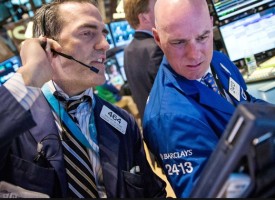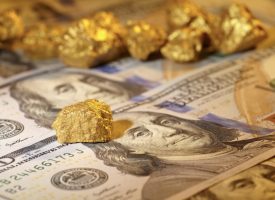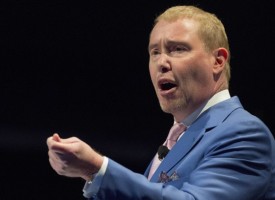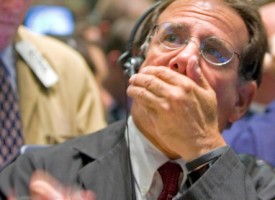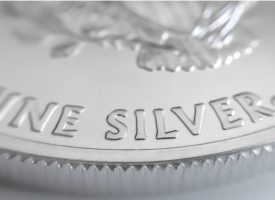People across the globe are struggling with the curse of inflation, and soon they will witness the rise of gold.
The Curse Of Inflation
September 2 (King World News) – Alasdair Macleod: Remarkably, in a speech on monetary policy given at the Jackson Hole conference last Friday, Jay Powell never mentioned money, money supply, M1 or M2. With money supply expanding at a record pace to fund both QE and intractable budget deficits the omission is extraordinary.
The FOMC (the rate setting committee) appears to no longer take the consequences of monetary expansion into account. But the fact is that rising consumer prices caused by monetary expansion have driven real rates sharply negative and are leading to pressure for higher interest rates.
This article looks at the consequences of policies which combine the maintenance of a wealth effect by juicing markets with QE, and funding enormous government deficits, which are now beyond control. A flight out of foreign-owned dollars and dollar-denominated financial assets, which currently total over $32 trillion, is becoming inevitable.
Will the Fed respond by increasing its QE support for financial markets, while resisting the pressure of rising interest rates? If so, there is no surer way to destroy the dollar.
The lessons from history combined with sound economic analysis tell us that markets will reassert themselves over the Fed, and for that matter, over all other central banks which have embarked on similar monetary policies.
Gold is the ultimate hedge against these events and their consequences…
To hear Sean Boyd discuss $3,000 gold and the big game-changer
for the gold market CLICK HERE OR ON THE IMAGE BELOW.
Introduction
Last week, in his Jackson Hole speech Jay Powell grudgingly admitted that prices might rise a bit more than the FOMC previously thought. But it was too early to conclude that policies should be adjusted immediately. He said:
“Over the 12 months through July, measures of headline and core personal consumption expenditures inflation have run at 4.2% and 3.6% respectively— well above our 2 per cent longer-run objective. Businesses and consumers widely report upward pressure on prices and wages. Inflation at these levels is, of course, a cause for concern. But that concern is tempered by a number of factors that suggest that these elevated readings are likely to be temporary. This assessment is a critical and ongoing one, and we are carefully monitoring incoming data.”
In other words, with prices rising at over double the 2% target, there’s nothing to worry about. But be reassured, the Fed is on the case.
This was followed by
“Policymakers and analysts generally believe that, as long as longer-term inflation expectations remain anchored, policy can and should look through temporary swings in inflation. Our monetary policy framework emphasises that anchoring longer-term expectations at 2 per cent is important for both maximum employment and price stability.”
In other words, because inflation is always 2 per cent and Humpty-Dumpty insists it is so, markets will return to the 2 per cent target. Incidentally, when someone invokes belief, it is either the product of faith or lack of knowledge. This is why politicians cite faith a lot, and we should be wary when it is a justification for monetary policy.
There is, of course, one glaring problem with all this as Powell admits before dismissing it: “businesses and consumers widely report upward pressure on prices and wages”. There is an associated problem, an enormous elephant in the room that no official seems to be aware of, which independent analysts such as John Williams at Shadowstats.com points out, and that is if you strip out all the changes in statistical method that have deliberately reduced headline price rises since 1980, you find that according to an unadjusted CPI(U), prices are now rising at over 13% annualised.
Perhaps we should give Powell one out of ten for courage for participating at Jackson Hole, while zero points must be awarded to Christine Lagarde and Andrew Bailey, both having refused to take part in the symposium when at other times they would surely have welcomed the chance to be in the limelight on the global monetary stage. We are left wondering why they preferred not to justify their monetary policies in such a forum.
But if Powell gets one point for at least appearing, he gets at least nine out of ten for evasion. A word-search of his speech reveals why. It is headlined about monetary policy. But money was only mentioned once, and that was in the title of one of the references at the end. Not even when discussing longer-term inflation expectations was money mentioned. And word searches for M1 and M2 show nothing. The Fed’s monetary policy does not appear to involve money.
To be clear, the chart in Figure 1 has nothing to do with rising prices, according to Jay Powell.
Figure 1 shows narrow money supply before it was amended to include former categories of broader M2 money last February, rendering it useless for comparative analysis. Narrow money supply is going off the scales. Yet at Jackson Hole it was never mentioned, except in a footnote. Equally incredible is the gullibility of the investment establishment knowing that money does matter yet was drawn into the Fed’s non-monetary narrative.
The relationship between prices and money
Like the child in the fable who observed the emperor had been conned into wearing no clothes, a child today with an elementary grasp of arithmetic will understand that if you increase the quantity of something, each unit will be worth less. Today’s masters of the monetary universe seem unaware of the fact. They have written many erudite books and articles, made speeches as we saw last week, in ignorance of or wishing away monetary facts.
The consequences of debasement are therefore ducked. Interventionists dismiss the Cantillon effect, whereby prices increase in the wake of the new money being spent into circulation. Have they even heard of it? As an unarguable fact, it should be indisputable. And clearly, rising prices are a consequence of the massive increase in circulating currency evidenced in Figure 1 above, and not due solely to an imbalance between production and consumer demand which will correct in time, as Powell claimed at Jackson Hole.
Economic dislocation is part of and at the same time an additional factor to monetary expansion behind price increases. It arises from monetary inflation distorting markets, which continue to be disrupted by the covid pandemic. Covid-related disruption will continue into the foreseeable future, most noticeably due to logistical foul-ups, trading nations going in and out of lockdowns and other related restrictions on commerce. But at base, increases in the general level of prices occur as newly issued currency enters circulation.
The Fed overseas two separate mechanisms for currency expansion. Quantitative easing is targeted at providing investing institutions with cash in return for low-risk assets, specifically US Treasury and agency bonds to the tune of $120bn every month. This QE has the effect of keeping bond yields suppressed and equity markets inflated because of the targeted institutions’ reinvestments. In addition — and it is separate from QE — there is the government’s budget deficit, theoretically financed out of private sector savings, but in the absence of an increase in the savings ratio, financed through the expansion of currency and credit.
Fund raising for the government is about to become chaotic
We can see that the Fed’s non-monetary approach to monetary policy begs important questions, but there are usually reasons behind it which we must consider. They give us a steer to the Fed’s real mission; its twin objectives of 2% price inflation and full employment having become secondary. It is to keep the Federal government financed by suppressing the interest cost and encouraging the expansion of bank credit to subscribe for government debt. The latter task was made easier during covid lockdowns, since unspent income temporarily accumulated in the financial system, which together with currency and credit expansion led to the government being awash with funds. But that has now changed, as the balance on the government’s general account at the Fed in Figure 2 shows.
Since March 2020, when the balance was $380bn, the government accumulated a further $1.437 trillion to a balance of $1.817 trillion in a little over four months, funded by a mixture of currency and credit inflation to fund extra government debt. Since August last year, all that accumulation and a little more has been spent into general circulation, leading to liquidity flooding the economy. This liquidity has been absorbed by the Fed’s reverse repo (RRP) balances expanding to over a trillion dollars. The increase in RRPs had been necessary to prevent bank deposit and money market rates from going negative due to excessive liquidity.
The effect on the dollar of the RRP level increasing has been to stabilise it on the foreign exchanges and to pause the headlong increase in commodity and raw material prices for the last few months. But this will almost certainly turn out to be a temporary effect. Assuming the debt ceiling will be raised in the coming weeks (it is inconceivable that either it will not or it will be suspended) the US Government will resume selling US Treasuries and T-bills into the market to top up its general account and fund its ongoing deficit. No doubt, the plan initially is for the Fed to accommodate this demand by reducing its outstanding RRP balances, thereby keeping its funds rate at the zero bound, and therefore yields on US Treasury stock suppressed.
The best laid plans need numbers to add up, and immediately we can see a problem. The Fed may have a trillion up its sleeve in the form of RRPs which can be wound down. But the Biden administration is planning $6 trillion spending in fiscal 2022, rising to $8.2 trillion by 2031. Combined with a structural deficit, the government deficit next year will almost certainly be substantially higher than the Congressional Budget Office’s current forecasts. Furthermore, the CBO assumes the annual average growth of “real” GDP will average 2.8% during fiscal 2021—2025, an assumption that is looking optimistic, given the unexpected increase in the price deflator.
In recent years the CBO’s forecasts have turned out to be overly optimistic. Furthermore, disruption of global logistics is an ongoing problem, so the supply of products to satisfy the increase in consumer spending assumed in the forecasts will continue to be restricted well into 2022. Covid disruptions have not ended and increases in infections are likely in the coming months. It all adds up to a recovery in tax revenues being postponed again, and government spending being increased more than budgeted, even before taking Biden’s proposed extra spending into account.
The CBO’s optimistic assessment of the government deficit for next year is $1.153 trillion, reducing from over $3 trillion in the current year. Allowing for all the factors listed above, more realistically, another $3 trillion deficit is likely to be the minimum for fiscal 2022, which commences at the end of this month…
New interview from legend Doug Casey discussing gold, silver and
global chaos! To listen click here or on the image below.

Therefore, the simple problem is one of the Fed only being able to release one trillion of RRP liquidity into a market that will face demands for three trillion or more, being the likely fiscal deficit for 2022. We are back to where we were in March 2020, when the CBO forecast the deficit at $1.073 trillion, but the outturn was $3.13 trillion.
The problem for the US Treasury is it cannot close the fiscal gap, even if it wanted to — which it doesn’t. Putting record budget deficits to one side, the neo-Keynesian script demands yet more stimulus. But consumer prices are rising and are continuing to do so as the economy falters. Raising the general level of taxation would obviously be counterproductive and cutting government spending is politically impossible — not least because spending $6 trillion is Biden’s committed plan. No wonder he is looking for ways to tax the rich to fund his planned spending, but even his economic advisers must realise the numbers simply don’t stack up.
With the Biden administration unable to reduce its budget deficit, a rising interest rate environment, reflecting price inflation, is bound to result in a funding crisis. These are the debt trap circumstances which not only deters foreign ownership of the currency but persuades foreigners to dump existing currency holdings in increasing amounts. It is the downside of the Triffin dilemma, when decades of irresponsible fiscal policy are encouraged to supply foreigners with a reserve currency. Inevitably, it ends with a currency crisis. It is what led to the gold pool failure in the late 1960s and ended the Bretton Woods agreement in 1971. And according to the Treasury’s own TIC figures, foreign investment in dollar-denominated financial assets and cash now exceeds $32 trillion, roughly 150% of US GDP. The dollar has never been so over-owned by flaky foreign interests.
The impact on the dollar
While Powell hinted in his speech that tapering QE at some point is on the cards, it will simply not be possible if a similar budget deficit to this year is to be funded in 2022. Furthermore, in real terms interest rates are now deeply negative.
The impact on the dollar of another expansion of monetary policy on top of deeply negative real rates is likely to follow the pattern established in March last year. The Fed cut interest rates by 1.75% in two steps to the zero bound and announced monthly QE of $120bn. Foreigners at that time turned out to be particularly sensitive to these developments, driving the trade-weighted index down 13% between the Fed’s reflation announcements in March 2020 and January this year. More importantly, commodity and raw material prices moved significantly higher, or put more accurately the dollar lost substantial purchasing power in commodity markets. The gold price moved from a low of $1450 to a high last August of $2075.
But price inflation today is far higher than in March 2020, equivalent to a cut in interest rates into deeply negative territory in real terms — considerably greater than the 1.75% cut eighteen months ago. And the increasing certainty of rising interest rates and the effect on financial asset values rules out tapering — if anything, it is likely to be increased at the first sign of markets stumbling.
In March 2020, official price inflation measured by the CPI (U) was 1.5%. In July 2021, it was 5.4%, the equivalent of a cut in real interest rates of 4%. When they become more sensitive to the deficit arithmetic, the question now arises as to how foreigners will value the dollar against other currencies, and more importantly, against commodities. The dollar’s dead-cat bounce and the recent sideways consolidation in commodities and raw materials will not only be over, but the higher starting point for price inflation is likely to make their reactions more severe. The effect on US domestic prices are bound to reflect these factors, with price inflation increasing substantially from current levels…
Keith Neumeyer Just Predicted $100+ Silver And $3,000 Gold! TO LISTEN CLICK HERE OR ON THE IMAGE BELOW.
We can see that in theory the first trillion of the government’s budget deficit should not be too much of a funding problem, because the Fed has a trillion of RRPs to release, which in roundabout ways can be deployed into US Treasuries. But funding the likely higher deficit at current coupons will almost certainly turn into an impossibility. Not only are implied rates highly negative in real terms, but with price inflation rising even more, coupons will have to rise significantly. The possibility that Shadowstats might record true price inflation at over 20% becomes a live prospect.
Unless the American public increase their savings materially — which is highly unlikely and therefore can be ruled out — the budget deficit will be broadly mirrored in a continuing trade deficit. So not only will foreigners be dumping over-owned dollars, but they will have further dollars to sell as well.
Rising bond yields drives bear markets
With an increasing inevitability, yields on US Treasuries are bound to rise considerably from deeply negative real rates. And since equity markets take their cue from bond yields, the damage to values in those and all other financial assets will be substantial. The more so, because the Fed has pursued a policy of inflating values of all financial assets through unprecedented levels of QE. The mystery is why markets view talk of reducing QE with equanimity.
Experience informs us that market participants can be complacent for long periods, and that during such times, the monetary authorities can suppress interest rates and distort markets with impunity. We have been in such a period for decades. The American investing public is now fully predisposed to be unquestionably bullish of financial assets having not known a period when markets, and not the Fed, decided values. Like the Fed, investors only accept the inevitable consequences of currency inflation reluctantly.
When triggered by events, the discovery of true economic and financial conditions leads to market moves that can be violent, taking nearly everyone by surprise. The consequences are likely to become self-feeding, with rising bond yields imposed by markets on the Fed, rather than the other way round, making debt funding problems even worse.
The Fed doesn’t have a mandate to just stand back and let markets decide outcomes, which is what it should do and is going to happen eventually anyway. But rising interest rates create enormous problems not just for relative values in financial assets generally, but threatens to wipe out overly indebted borrowers, including over-leveraged businesses, corporate zombies and others burdened with unproductive debt. They will also undermine commercial and residential property markets. Even the solvency of the government becomes questioned. The days when a Paul Volcker can simply raise the Fed’s fund rate to whatever it takes to kickstart falling interest rates are clearly over.
The combination of Biden’s spending proposals and a stagnating economy is making it impossible for the Fed to continue to suppress interest rates and therefore bond yields. And it is equally impossible to see how the Fed can stop them from rising without sacrificing the dollar. Not only are we going to see a new trend of rising yields established, but very quickly it will be evident there is no visible end to it. These were the dynamics faced by Rudolf von Havenstein when he was President of the Reichsbank during Germany’s hyperinflation of 1921—1923. And we know what happened at that time. And as Jay Powell demonstrated at Jackson Hole, the importance he attributes to the consequences of monetary expansion mirrors that of von Havenstein.
The truth of an emerging situation is that America has changed from a low inflation economy with a gentle erosion of the dollar’s value artificially cheapening US Treasury debt, to a commitment to hyperinflation, the start of which was the rapid expansion of M1 money supply as shown in Figure 1 above…
With surface samples as high as a staggering 300,000
grams of silver, this company is looking to make
one of the largest silver discoveries in history!
CLICK HERE OR IMAGE BELOW TO FIND OUT MORE.

Meanwhile, equity markets have become wildly overvalued on the back of the Fed’s guarantee that they will never fall; that is the primary purpose of QE. A falling dollar and rising bond yields along the curve will almost certainly be the signal for the start of a bear market. And with foreign investors holding $13.3 trillion in US equities as of end-June (up $4.1 trillion in a year) foreign selling of both equities and the dollar proceeds could well be an early feature of a new bear market.
If the Fed loses control over rates, the bear market will be considerable. But the Fed is expected to keep economic confidence high. If it is to save markets, it will have to increase QE at the start of any significant fall in the S&P 500 Index — standing back and watching investors being hammered is not an option. This is why QE was reinstated in March 2020 and continues to this day at $120bn every month, amounting to $2 trillion so far.
The John Law precedent
If the inflation problem was simply one of runaway government spending, then the falling purchasing power of the currency would lead to ever greater demands on the printing presses. And the process would accelerate exponentially until the public realised there was no hope for the currency and hasten to rid themselves of it in a final collapse. This is the classic hyperinflation model, for which Germany’s well-documented monetary policies after the First World War are frequently cited.
But today’s circumstances include a commitment to ensure public confidence in financial assets is maintained by the state intervening to ensure their values remain buoyant. That is the primary purpose of quantitative easing, which we now see deployed in all major jurisdictions in the West and Japan. The consequence is that ever greater quantities of QE are required to maintain financial asset values. The policy is additional to interest rate suppression, which as I have pointed out above, is invaluable for the affordable funding of government deficits.
There is an historical precedent in the Mississippi bubble in France between 1718—1720. John Law created a similar wealth effect through a combination of monetary inflation and the encouragement of asset speculation. His objectives were firstly to reduce the royal debts, and secondly, having acquired a monopoly on France’s foreign trade, he needed to equip his Mississippi venture with ships and other infrastructure.
His method was to issue partly paid shares 10% down and the balance to be paid later. But when further issues were needed, earlier subscribers sold shares to take up their new rights to subscribe, and they also sold shares when calls were due. Law, who had also been appointed controller of the currency, printed livres to buy these shares back and support the price. But selling eventually overwhelmed the project in March 1720, and the shares fell from a peak of 10,000 livres to 4,000 livres by the following September. But the more significant casualty was the livre itself, which became worthless on the foreign exchanges in London and Amsterdam by the end of that month.
What concerns us is the similarity with today’s QE and Law acting as a director of the Banque Royale, a prototype central bank, and controller of the currency. Today, his actions would be described as quantitative easing. So far as I’m aware, while the connection is not made in the histories of the bubble, the expansion of the quantity of livres in circulation had begun to drive up prices, not just in Paris, but outwards into the countryside as well. The reason prices rose was the livre was losing purchasing power due to its inflation. The natural rate of interest on Law’s unexchangeable paper currency was therefore increasing, which became the final nail in the coffin of the Mississippi bubble.
The similarity with today’s intervention by central banks expanding the money quantity through QE to support markets is striking. It is a monetary policy, which initially suppresses the natural level of interest rates as the quantity of money increases, before it begins to lose purchasing power. It then fuels higher interest rates as its purchasing power begins to decline.
As noted above, from the peak of the Mississippi bubble the currency collapsed with the bear market in the shares over little more than six months. The use of currency printing to support the market failed for the reasons we can expect to be repeated today. By ending in a market related crisis, the normal process of currency destruction reflected in the Weimar model becomes foreshortened. Additionally, modern communications and the sheer scale of the global financial bubble today leads us to expect the end of fiat currencies to be swifter than that experienced in France just over 300 years ago.
Gold
The last time the consequences of Triffin’s dilemma hit the dollar was the failure of the gold pool in the late 1960s, which ended up driving the dollar off the last vestiges of a gold standard in 1971. The lesson was not learned. If anything, the imperative to produce dollars for export accelerated as US monetary policy was to replace gold with the dollar as the international monetary standard.
But one thing the US authorities could not wish away is the difference between a national currency and true money, the latter not being the product of credit creation. The benefit of a currency, to the issuer at least, is that it is the vehicle for transferring wealth to the government, its cronies, its licenced banks, and their favoured customers. Without currency, a government is severely limited financially.
Gold is the money naturally preferred by the people. A state-issued currency alternative inevitably suffers debasement, which is generally tolerated so long as it is not acute. The compounding debasement of the dollar since the Nixon shock in 1971 has removed about 98% of the dollar’s value, measured against gold. While the economic effect has not been beneficial —contrary to claims by neo-Keynesian economists — it has not been sufficiently marked to stop foreigners using the dollar for transactions and accumulating fixed interest bonds, bills and cash.
The evidence strongly points to foreigners’ tolerance already undermined by the fall in the dollar’s purchasing power since March 2020. At the margin, commercial entities will again alter the balance between owning useful materials and holding dollar cash in favour of the former, leading to a renewed bout of price increases for commodities. But measured against commodity and energy prices, over the very long-term gold tends to retain its purchasing power, which is why when currency debasement accelerates, measured in fiat currencies the price of gold rises.
Gold is and will remain the ultimate hedge against failing currencies and their economic consequences, and its importance has never been greater in modern times.
***ALSO JUST RELEASED: Look At These Fascinating Charts Of Gold, Silver, The Nasdaq And Real Estate CLICK HERE.
***ALSO JUST RELEASED: Here Is A Look At A Future Mega-Trend! Plus The Key To The Gold Bull Market CLICK HERE.
***To listen to James Turk discuss Friday’s big 4+% rally in the mining stocks along with the surge in gold and silver as well as what to expect next CLICK HERE OR ON THE IMAGE BELOW.
© 2021 by King World News®. All Rights Reserved. This material may not be published, broadcast, rewritten, or redistributed. However, linking directly to the articles is permitted and encouraged.








